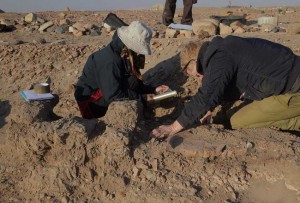Among other aspects of daily life activities, AcrossBorders aims at studying in detail the craft specialisation of functional ceramics associated with cooking and baking and various aspects of food preparation. Here, the co-existence of Egyptian style (wheel-made) and Nubian (hand-made) cooking pots as well as the import of real Egyptian cooking pots are of particular interest. Today, a large fragment of a cooking pot produced in Egypt was documented at SAV1East in Square 4B – obviously in situ, set into an ashy deposit next to a wall and still filled with some ashy material and charcoal.
Another really interesting in situ situation with a functional ceramic type was found in Square 4C: a large baking plate is still in place – close to a mud brick wall, sitting on a very ashy deposit.

Luckily a good portion of this 18th Dynasty baking plate was left in place despite the pitting of the area in Medieval/Ottoman times.
Until now, we only had small fragments of these plates from SAV1 East and otherwise hundreds of conical bread moulds (probably associated with the nearby Temple A). The new baking plate and its find context are therefore of particular interest – therefore we decided to take a micromorphological sample from the ashy deposit associated with this area (and nicely “sealed” by the baking plate on top) which might have functioned as temporary “kitchen”.
These new data from SAV1 East – ceramics, archaeological context and micromorphology – will contribute to a better understanding of some aspect of food preparation within the New Kingdom town of Sai.

